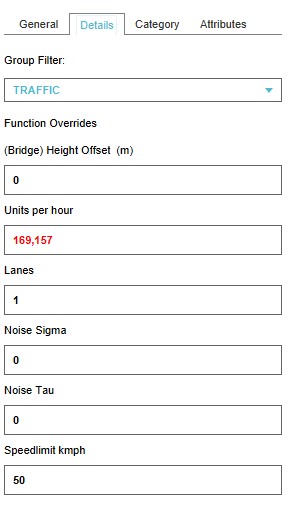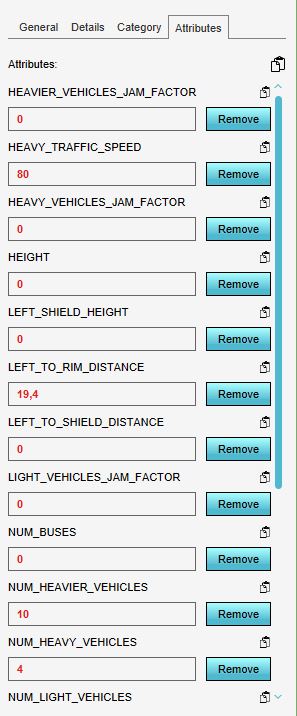Traffic Model
Traffic model in the Tygron Platform
The purpose of the default traffic model in the Tygron Platform is to calculate the effects of traffic on the 3D World through traffic intensity. In order to calculate this impact, data such as the number of lanes, traffic speed and the traffic intensity on a particular road is added to the project and can be updated. The traffic model is a static model that does not change by carrying out Actions, Upgrades or Measures for example. Read below how to create your own dynamic traffic model and use it in the Tygron Platform.
The following (dynamic) overlays show data from/effects of the traffic model: Traffic Density (Overlay), Traffic NO2 (Overlay), Traffic Noise (Overlay).
When generating a new project, traffic related data is added for the selected project area, based on available open data sources. The following datasets are used:
Traffic data
Traffic related data in the Tygron Platform, can be found on the Details tab of a Building and the Attributes tab.

Height offset
This field specifies the height offset of a bridge.
Units per hour
This field specifies the traffic intensity: the number of units that drive on the road in an hour. For the data source, see traffic intensity.
Lanes
This field specifies the number of lanes that a road can have.
Noise Sigma
This field specifies the correction factor at reference traffic speed [1].
This value is used in the calculation of the Traffic Noise (Overlay).
Noise Tau
This field specifies the correction factor per 10 km/hour deviation from reference traffic speed [2].
This value is used in the calculation of the Traffic Noise (Overlay).
Speedlimit
This field specifies the max allowed speedlimit on road or part of a road.

The attributes tab of a road shows more information, based on the available open data sources for this particular road and the matching of the data when generating the 3D model. Therefore, some roads have attributes from the NSL, visible in the image on the right.
These attributes are not yet used in any of the calculation models, but can be used to create own overlays or calculation models.
Each road has an NWB_ID attribute from the NWB.
Traffic intensity
The traffic intensity is depicted in the Platform by the Units per hour attribute (in the software named TRAFFIC_FLOW).
When generating a new project, the traffic intensity is assigned based on available data sources. When the Units per hour attribute text color is black, the intensity is a default value based on the function type. When the Units per hour attribute text color is red, the data is from one of the following datasets.
When the road is a highway, the data is usually from INWEVA 2015.
Otherwise, the intensity is based on the VI-Lucht & Geluid model (see for more information: https://www.infomil.nl/onderwerpen/lucht-water/luchtkwaliteit/slag/hulpmiddelen/inschatten/).
This Excel based traffic model estimates traffic intensity based on the following road characteristics:
- Traffic speed
- Is the road a one way street?
- Is the road inside an urban area or not (NL: binnen of buiten de bebouwde kom)?
- Is there a separate cycle path along the road?
- Are there more than 2x2 lanes?
- Is parking along the road possible?
These characteristics combined with the urbanization factor, determines the type of road. In the VI-Lucht & Geluid model, the different road types have different average traffic intensities. The average daytime traffic intensity is converted to an hourly value to be used for the TRAFFIC_FLOW attribute.
Add a custom Traffic Model
It is also possible to creata and add a custom traffic model, better suited for your use case. The traffic model can be either a static model (the model and data do not change in the project) or a dynamic model (the model and data change when something in the 3D world changes).